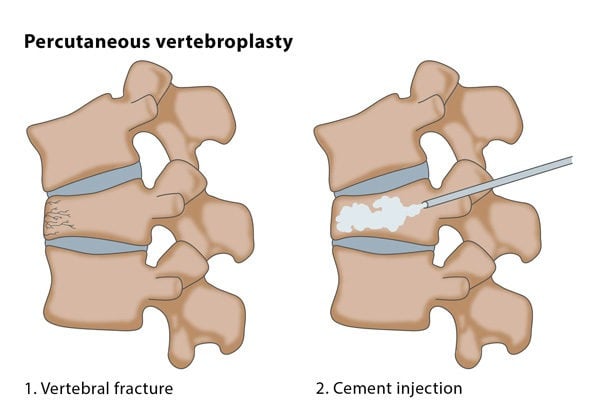Vertebral augmentation
What is a vertebral augmentation?
Percutaneous vertebroplasty is a minimally invasive procedure in which cement designed for use in bones is injected into the vertebral column (spine).
You may be recommended for this procedure if you are suffering from pain caused by a vertebral compression fracture. This means that a vertebra (part of your spine) has collapsed, possibly due to a fall or the weakening of the vertebra. The cement functions as a sort of internal cast, providing pain relief and stabilising the affected area of the spine.

Kyphoplasty is when balloons are inserted into the compressed vertebra under CT or fluoroscopic guidance. If you have suffered a fracture due to trauma or have significant height loss caused by a fracture, your doctor may recommend that you undergo kyphoplasty.
Vertebral augmentation is used to restore height by introducing an artificial vertebra. This may be followed with the injection of bone cement for the treatment of painful vertebral fractures, especially ones caused by trauma or entailing a significant loss of height.

How does the procedure work?
Vertebroplasty and kyphoplasty are usually out-patient procedures. However, they are occasionally performed under general anaesthetic, and in these cases patients are kept in hospital overnight.
You will lie on your stomach and will be given a local anaesthetic. The interventional radiologist will insert a needle into the spine using X-rays (sometimes combined with CT) to guide the needle, and will inject bone cement to the targeted area to make sure the bone does not collapse again.
During the kyphoplasty procedure, two balloons are inserted and inflated before the injection of the bone cement, while, in the other vertebral augmentation procedures mentioned above, an implant is expanded before being inserted into the vertebral area.
If you are given a local anaesthetic, you will be kept in hospital for two hours after surgery to be monitored before being discharged.

Why perform it?
Vertebral augmentation can be performed to ease back pain which is caused by vertebral compressive fractures. Vertebral fractures are a common cause of pain and disability and are associated with increased mortality.
What are the risks?
A large number of studies have found vertebral augmentation to be an effective and safe way to treat vertebral fractures, especially when high-quality image guidance is used.
You may experience minor complications such as an infection, an allergic reaction or bleeding from the puncture site. You may also experience the accidental blockage of a vein in your lower back, small cement leaks in the soft tissue around the vertebrae, inflammation of part of the spinal nerve, or a small blockage in your lung.
Unfortunately, there are a number of possible severe side effects, though these are rare. Severe side effects include cement leaks into the surrounding area (a condition which requires immediate surgery), spinal cord direct lesion, which can lead to disability, and a large blockage in the lung, which can cause acute respiratory failure and death.
Flow chart for patients

